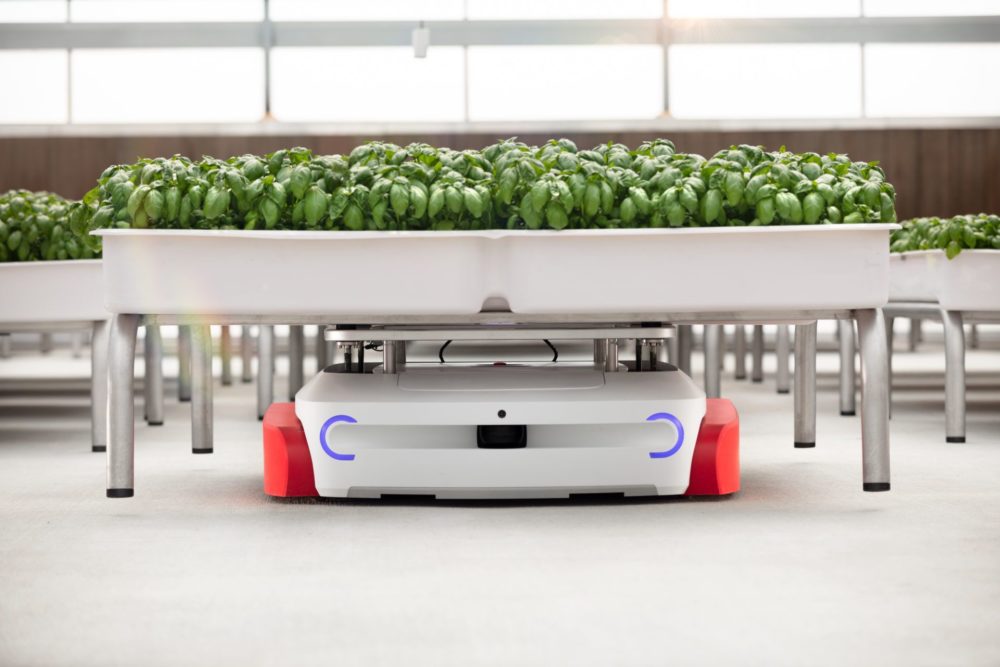US-based indoor ag startup Iron Ox has raised $50 million in a Series C funding round led by climate-focused investor Breakthrough Energy Ventures.
Other investors included Crosslink Capital, R7 Partners, Pathbreaker Ventures, i/o Ventures, Amplify Partners, ENIAC Ventures, Tuesday Ventures, At One Ventures, and Y Combinator. The injection of capital brings Iron Ox’s total funding to date to $98 million.
A big part of the new funds will go towards launching its latest facility, a greenhouse operation in Lockhart, Texas.
Founded in 2015, Iron Ox operates two other farms: one at its headquarters in the San Francisco Bay Area, and a greenhouse just south of that in Gilroy, California. The Lockhart farm will be Iron Ox’s third and largest facility, and will grow a mix of leafy greens, berries, and herbs. Like the company’s other locations, it will be a semi-autonomous farm relying on both humans and robots to execute tasks around the farm. For example, human growers will inspect and prune plants, while robots and robotic arms can handle more repetitive tasks like seeding and moving grow trays.
It’s no coincidence that Breakthrough Energy led this round. The investment group founded by Bill Gates is dedicated to helping the world achieve net-zero emissions by 2050, and chooses its portfolio companies accordingly.
“They have a mandate where you have to be able to show you can reduce climate change,” Iron Ox CEO Brandon Alexander tells AFN. “They were very serious about it. They grilled us hard for quite a while.”
Iron Ox passed muster partly because the company has its own goal of eventually achieving net-zero emissions across its farms – and helping the wider agricultural sector do the same.
“Every joule of energy, every gram of nitrogen, every liter of water should create a calorie,” says Alexander of the ideal farming operation. “[That] seems great in theory, but the problem is, understanding the plant at that level of detail is a little beyond our understanding today.”
Data is one way to get closer to that level. Alexander says that the Iron Ox system scans each plant on the farm to create 3D images that plant scientists and AI specialists can examine to look for problems – such as discoloration, tip burn, or aphids. “The plant itself gives a lot of early warning signs about how it’s doing,” he says.
Alexander is quick to add that data by itself isn’t all that useful: “You don’t just want cool images; you want to actually do something with it.”
“The interesting thing about our farm is that there is the data collection side but there is also the taking action side,” he continues. “And so obviously we have robots and robotic arms, but we also have our own dosing system and we developed our own hydroponic system. The reason for that was because we wanted that level of granularity, so that if we notice an issue on one pallet, we want to be able to respond.”
For example, Iron Ox’s system might detect a nutrient deficiency in the water of one pallet of plants. Once that data is fed back into the loop, the system can automatically suggest an appropriate action to increase nutrient delivery to that particular pallet.
It is this sort of approach that Alexander hopes will eventually make Iron Ox “one of the most efficient farms out there.”
More importantly, it will accelerate the company towards net-zero.
“Hydroponics is a great first step and an important step, but I don’t think we should applaud ourselves yet,” Alexander says. “We have to take that next step, we have to get to zero waste. And that means an understanding of the plant itself in a way that we just have to push the envelope on.”




